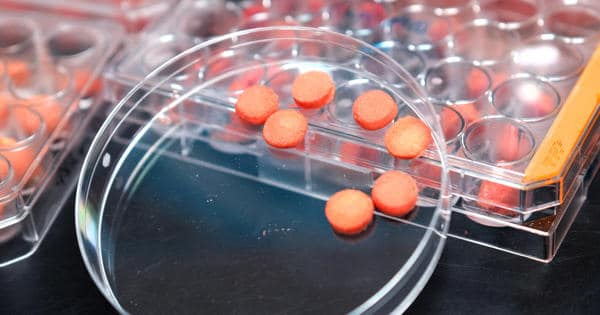Researchers have developed a reusable, biodegradable sponge that can readily absorb oil and other organic solvents from contaminated water sources, making it a promising alternative for dealing with marine oil spills. The sponge, which is made of sunflower pollen, is hydrophobic due to its natural fatty acid coat. The sponge’s ability to absorb oil contaminants of various densities, such as gasoline and motor oil, was demonstrated in lab experiments at a rate comparable to that of commercial oil absorbents.
The sponge, which is made of sunflower pollen, is hydrophobic (it repels water) due to a natural fatty acid coat on the sponge. The sponge’s ability to absorb oil contaminants of various densities, such as gasoline and motor oil, was demonstrated in lab experiments at a rate comparable to that of commercial oil absorbents.
Oil spills are difficult to clean up and cause long-term harm to the marine ecosystem. Conventional cleanup methods, such as using chemical dispersants to break down oil into very small droplets or absorbing it with expensive, non-recyclable materials, may exacerbate the problem. So far, the researchers have created sponges with a diameter of 5 cm. The research team, comprised of scientists from NTU Singapore and Sungkyunkwan University in South Korea, believes that when scaled up, these sponges could be an environmentally friendly alternative to dealing with marine oil spills.
A team of scientists led by Nanyang Technological University, Singapore has created a reusable, biodegradable sponge that can readily soak up oil and other organic solvents from contaminated water sources, making it a promising alternative for tackling marine oil spills.
The study’s principal investigator, Professor Cho Nam-Joon of the NTU School of Materials Science and Engineering, stated: “By fine-tuning the material properties of pollen, our team was able to create a sponge that can selectively target and absorb oil in contaminated water sources. Using a natural material also makes the sponge more affordable, biodegradable, and eco-friendly.”
By transforming pollen’s tough shell into microgel particles, this study adds to NTU’s body of work on finding new uses for pollen, known as the diamond of the plant kingdom for its hard exterior. This soft, gel-like material is then used to construct a new class of environmentally sustainable materials.
Prof Cho led a research team last year, along with NTU President Professor Subra Suresh, to create a paper-like material from pollen as a greener alternative to paper made from trees. This ‘pollen paper’ also bends and curls in response to changes in humidity, which could be useful for soft robots, sensors, and artificial muscles.
Prof Cho, who also holds the Materials Research Society of Singapore Chair in Materials Science and Engineering, went on to say: “Pollen that isn’t used for plant pollination is frequently regarded as biological waste. We try to find new uses for this ‘waste’ and turn it into a renewable, affordable, and biodegradable natural resource through our work. Pollen is biocompatible as well. When exposed to body tissues, it does not cause an immunological, allergic, or toxic reaction, making it potentially suitable for applications such as wound dressing, prosthetics, and implantable electronics.”
The findings were published in the scientific journal Advanced Functional Materials.
Building a sponge from pollen
To create the sponge, the NTU team first converted the ultra-tough pollen grains from sunflowers into a pliable, gel-like material using a chemical process similar to that used to make soap. After removing the sticky oil-based pollen cement that coats the grain’s surface, the pollen is incubated in alkaline conditions for three days. The gel-like material that resulted was then freeze-dried.
As a result of these processes, pollen sponges with 3D porous architectures were formed. After repeatedly absorbing and releasing liquids, the sponges were briefly heated to 200°C, which stabilized their shape and structure. Heating also improved the sponge’s resistance to deformation by a factor of two, according to the researchers.
The sponge was coated with stearic acid, a type of fatty acid found commonly in animal and vegetable fat, to ensure that it selectively targets oil and does not absorb water. This makes the sponge hydrophobic while preserving its structural integrity.
Oil-absorption tests were performed on the pollen sponge with oils and organic solvents of varying densities, such as gasoline, pump oil, and n-hexane (a chemical found in crude oil). They discovered that the sponge had an absorption capacity ranging from 9.7 to more than 29.3 g/g. This is comparable to the absorption capacity of commercial polypropylene absorbents, which are petroleum derivatives with absorption capacities ranging from 8.1 to 24.6 g/g. They also put the sponge through its paces by repeatedly soaking it in silicone oil and squeezing the oil out. They discovered that this process could be repeated at least ten times.
The team tested the ability of a sponge 1.5cm in diameter and 5mm in height to absorb motor oil from a contaminated water sample in a final proof-of-concept experiment. In less than 2 minutes, the sponge absorbed the motor oil.
“These findings show that the pollen sponge can selectively absorb and release oil contaminants and has comparable performance levels to commercial oil absorbents while exhibiting compelling properties such as low cost, biocompatibility, and sustainable production,” said Prof Cho, the study’s corresponding author.
In the future, the researchers intend to increase the size of pollen sponges to meet industry demands. They are also looking to collaborate with non-governmental organizations and international partners to conduct real-world pollen sponge pilot tests. “We hope that our innovative pollen materials will one day replace widely used plastics and contribute to addressing the global issue of plastic pollution,” Prof Cho said.













